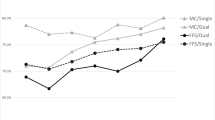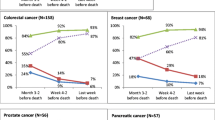Background
Although hospice care can alleviate suffering at the end of life for patients with cancer, it remains underutilized, particularly by African Americans and Hispanics.
Objective
To examine whether the racial composition of the census tract where an individual resides is associated with hospice use.
Design
Retrospective analysis of the Surveillance, Epidemiology, and End Results–Medicare file for individuals dying from breast, colorectal, lung, or prostate cancer (n = 70,669).
Measurements
Hospice use during the 12 months before death.
Results
Hospice was most commonly used by individuals who lived in areas with fewer African-American and Hispanic residents (47%), and was least commonly used by individuals who lived in areas with a high percentage of African-American and Hispanic residents (35%). Hispanics (odds ratio 0.51, 95% confidence interval 0.29–0.91) and African Americans (0.56, 0.44–0.71) were less likely to use hospice if they lived in a census tract with a high percentage of both African Americans and Hispanics than if they lived in a low minority tract. African Americans and whites were less likely to receive hospice care if they lived in a census tract with a high percentage of Hispanics than if they lived in a low minority area.
Conclusions
Increasing hospice use may require interventions to improve the delivery of hospice care in minority communities.
Similar content being viewed by others
References
Teno JM, Clarridge BR, Casey V, et al. Family perspectives on end-of-life care at the last place of care. JAMA. 2004;291(1):88–93.
Wallston KA, Burger C, Smith RA, Baugher RJ. Comparing the quality of death for hospice and non-hospice cancer patients. Med Care. 1988;26(2):177–82.
National Hospice and Palliative Care Organization. National Hospice and Palliative Care Organization’s 2004 Facts and Figures. USA; 2004.
Christakis NA, Escarce JJ. Survival of Medicare patients after enrollment in hospice programs. N Engl J Med. 1996;335(3):172–8.
Virnig BA, Marshall McBean A, Kind S, Dholakia R. Hospice use before death: variability across cancer diagnoses. Med Care. 2002;40(1):73–8.
Iwashyna TJ, Chang VW, Zhang JX, Christakis NA. The lack of effect of market structure on hospice use. Health Serv Res. 2002;37(6):1531–51.
Greiner KA, Perera S, Ahluwalia JS. Hospice usage by minorities in the last year of life: results from the National Mortality Followback Survey. J Am Geriatr Soc. 2003;51(7):970–8.
Virnig BA, Kind S, McBean M, Fisher E. Geographic variation in hospice use prior to death. J Am Geriatr Soc. 2000;48(9):1117–25.
Massey DS, Denton NA. American apartheid: segregation and the making of the underclass. Cambridge, Mass.; London, Eng.: Harvard University Press; 1993.
Bach PB, Guadagnoli E, Schrag D, Schussler N, Warren JL. Patient demographic and socioeconomic characteristics in the SEER–Medicare database applications and limitations. Med Care. 2002;40(8 suppl):IV–19–25.
Skinner J, Weinstein JN, Sporer SM, Wennberg JE. Racial, ethnic, and geographic disparities in rates of knee arthroplasty among Medicare patients. N Engl J Med. 2003;349(14):1350–9.
McCarthy EP, Burns RB, Ngo-Metzger Q, Davis RB, Phillips RS. Hospice use among Medicare managed care and fee-for-service patients dying with cancer. JAMA. 2003;289(17):2238–45.
Jargowsky PA. Urban poverty, race, and the inner city: The bitter fruit of thirty years of neglect. In: Harris F, Curtis L, eds. Locked in the poorhouse: cities, race and poverty in the United States. Oxford: Rowman and Littlefield; 1998.
Groeneveld PW, Laufer SB, Garber AM. Technology diffusion, hospital variation, and racial disparities among elderly Medicare beneficiaries: 1989–2000. Med Care. 2005;43(4):320–9.
Morrison RS, Wallenstein S, Natale DK, Senzel RS, Huang LL. “We don’t carry that”—failure of pharmacies in predominantly nonwhite neighborhoods to stock opioid analgesics. N Engl J Med. 2000;342(14):1023–6.
Green CR, Ndao-Brumblay SK, West B, Washington T. Differences in prescription opioid analgesic availability: comparing minority and white pharmacies across Michigan. J Pain. 2005;6(10):689–99.
Colon M, Lyke J. Comparison of hospice use and demographics among European Americans, African Americans and Latinos. Am J Hospice Palliat Care. 2003;20(3):182–90.
Crawley L, Payne R, Bolden J, Payne T, Washington P, Williams S. Palliative and end-of-life care in the African American community. JAMA. 2000;284(19):2518–21.
Whiteis DG. Hospital and community characteristics in closures of urban hospitals, 1980–87. Public Health Rep. 1992;107(4):409–16.
McLafferty S. Neighborhood characteristics and hospital closures. A comparison of the public private and voluntary hospital systems. Soc Sci Med. 1982;16(19):1667–74.
Krakauer EL, Crenner C, Fox K. Barriers to optimum end-of-life care for minority patients. J Am Geriatr Soc. 2002;50(1):182–90.
Gordon AK. Deterrents to access and service for blacks and Hispanics: the Medicare Hospice Benefit, healthcare utilization, and cultural barriers. Hosp J. 1995;10(2):65–83.
Blackhall LJ, Frank G, Murphy ST, et al. Ethnicity and attitudes towards life-sustaining technology. Soc Sci Med. 1999;48:1779–89.
Mitchell JM, Hadley J, Gaskin DJ. Physicians’ responses to Medicare fee schedule reductions. Med Care. 2000;38(10):1029–39.
Acknowledgements
We thank Joan Warren, PhD for her helpful comments on an earlier version of this manuscript. This work was supported by the National Cancer Institute (R01 CA112451). Partial support was also received from the Agency for Healthcare Research and Quality (P01 HS010856).
Potential Financial Conflicts of Interest
None disclosed.
Author information
Authors and Affiliations
Corresponding author
Rights and permissions
About this article
Cite this article
Haas, J.S., Earle, C.C., Orav, J.E. et al. Lower Use of Hospice by Cancer Patients who Live in Minority Versus White Areas. J GEN INTERN MED 22, 396–399 (2007). https://doi.org/10.1007/s11606-006-0034-y
Published:
Issue Date:
DOI: https://doi.org/10.1007/s11606-006-0034-y




